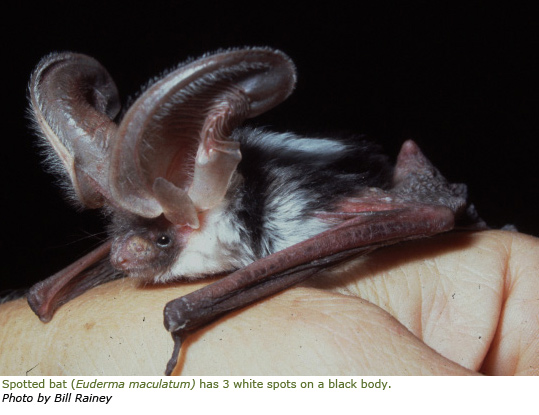Find a quiet spot to sit any warm evening in Yosemite by a river or open meadow and you can see the acrobatics of bats. In fact scientists were so fascinated by these tiny fighter jets, they began studying how they were able to fly so adeptly, even in the dark. While they discovered that most bats can see just about as well as us humans, many have the added advantage of echolocation. From studying the echolocation used by bats scientists got the idea for sonar. The bat emits a noise which bounces off of the objects around it and back to the ear of the bat, allowing it to create a sound picture. Echolocation works so well that bats are able to detect objects as fine as a human hair. This is good news! Unless your hair is full of moths, you never have to worry about a bat flying into and becoming tangled in your hair. While most bats echolocate at a frequency higher than humans can hear, you may be lucky enough to hear the clicking of a Spotted bat (Euderma maculatum) or the high pitched chatter of a Western mastiff bat (Eumops perotis) while they dive about catching dinner.

While it is easy to see the differences between us and bats, they may be more similar to us than previously thought. Their order, Chiroptera, literally means “hand-wing.” Much like us, bats have four fingers as well as a thumb, their fingers just happen to be connected by skin making them the only mammal that is able to fly. They are social creatures. Mother bats most often birth one pup at a time. The mothers leave their young together in a nursery colony. Upon returning each night, they are able to identify their own offspring, at times among over a million of other young. Bats are able to recognize individuals throughout their lives and, much as we do, maintain different levels of friendships with other bats.
Next time the light starts to dim, wherever you might find yourself, look to the sky. You don’t have to be in Yosemite to see bats. They live everywhere in the world except the Arctic and Antarctic. Even in urban areas bats can be found swooping about tirelessly reducing the insect population each night. Maybe you’ll be so dazzled by their flying tactics, thankful for their insect catching, and reminded of our similarities, you’ll forget to scream and find a new appreciation for these furry little fliers.
